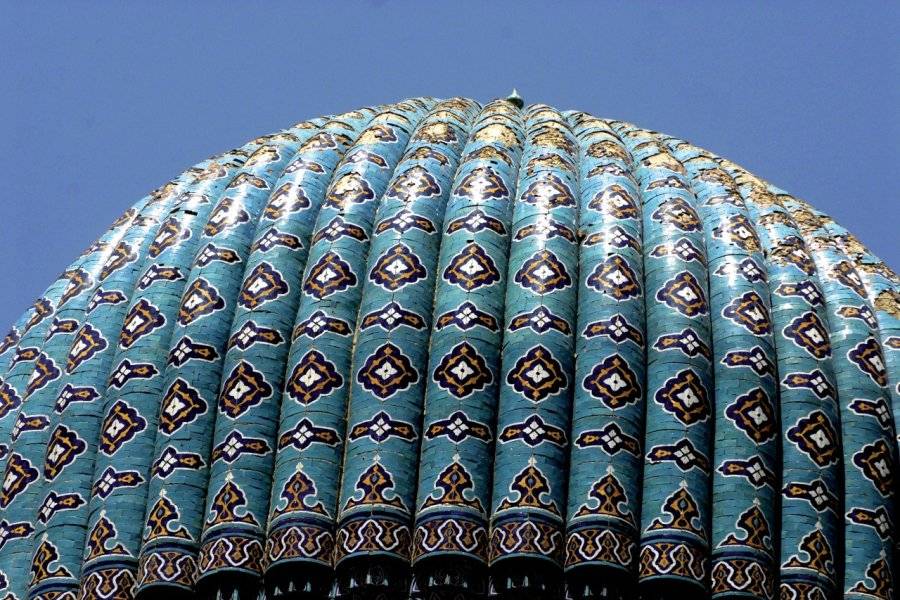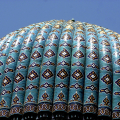BIBI KHANUM MOSQUE
Go there and contact
For the traveller arriving by car from Tashkent, the huge blue dome of Bibi Khanum rising behind the compact and colourful crowd on their way to the market is one of the first images of Samarkand the Timurid. It was in 1399, on his return from his campaign in India where his troops had set fire to the temples of the Zoroastrian and Hindu infidels, that Tamerlan decided to build the Masjid-i-Jami mosque, known today as Bibi Khanum, daughter of the Emperor of China and Tamerlan's favourite woman. The best architects and craftsmen from Khorassan, Azerbaijan and India worked on the construction of what was to be the largest mosque in Central Asia. The best location in the capital was chosen and Tamerlan laid the foundation stone on the most auspicious day, the fourth day of Ramadan 801 (10 May 1399). Ninety-five elephants, which Tamerlan had brought back from his conquests in Hinduhistan, maneuvered huge blocks of stone needed for construction. According to Cherif id Din, there were four hundred and eighty five-metre high blocks! Entrusting the supervision of the grandiose project to his most faithful collaborators, Tamerlan set off on new conquests in Asia Minor, and did not return to Samarkand until July 1404. According to Ruy Gonzalez de Clavijo, a Castilian ambassador and keen observer who visited Samarkand in August 1404, Tamerlan's first wife was actually named Cano. She was the daughter of Chiacao, emperor of the province of Samarkand and former king of Persia and Damascus, and it was in honour of Cano's mother that the mosque was built. Clavijo recounts how, on his return from Asia Minor, Tamerlan considered the gate too low and had it demolished and then rebuilt. The workers who took turns day and night were treated rather harshly. Those who worked in the pits had meat thrown at them like dogs, sometimes adding coins so that they could continue their hard work without respite. According to the historian Sharaf ad-Din, upon his return in 1404, Tamerlan fell into a black fury because Bibi Khanum, who must have been a strong-willed woman, had a madrasah and mausoleum built for herself right in front of the mosque. As later archaeological excavations showed, Tamerlan's fury may have been due to the fact that the madrasah's portal was not built in parallel with the mosque's portal. Whatever was the real reason for the Iron Emir's anger, legend has taken hold of it and the following story is told: while Tamerlan was fighting far from his lands, Bibi Khanum decided to surprise him by erecting the highest mosque ever built. Asked to hurry up, the architect ends up getting a kiss from her in exchange for her promise to finish the work on time. The kiss was so torrid and so hot that Bibi Khanum still had a mark on his cheek when the emperor returned. This one went into a frenzy. The felon architect climbed to the top of one of the minarets and flew forever to Persia. Bibi Khanum was thrown from the top of another minaret, and Tamerlan gave the order that in his empire all women should wear the veil so that their faces would no longer tempt the men when the husbands were at war.
At the time of its construction, the complex included four marble-paved galleries, covered with 400 domes and supported by 400 marble columns, which surrounded a huge inner courtyard measuring 130 m by 102 m. Two 50 m high minarets stood on either side of the 35 m high entrance portal and the portal of the large prayer hall, which was 40 m high. Four other minarets were located at each outer corner of the courtyard. To the north and south, two smaller mosques, each decorated with a dome resting on a lavishly decorated cylindrical drum, looked towards the centre of the courtyard where the Qur'an of Osman, the second largest Qur'an in Islam, dating from the seventh century, which Tamerlan brought back from Damascus, rested on a marble lectern. It is said that the suras were written in such large letters that imams could read them from the top of the colonnade. It is also said that as soon as it was finished, the mosque was already beginning to deteriorate. The haste of the architects probably had something to do with it and the earthquakes, one of which had its epicentre in the very centre of the mosque, did the rest. Armin Vambery, the false dervish who managed to visit Samarkand in 1863, describes a very damaged monument which was used as a garage for carts. Ten years later, Eugene Schuyller also went to Samarkand and described the courtyard of the mosque, which had been transformed into a cotton market: the large marble lectern on which the Koran Osman was placed was still there. He also reported on the popular belief that, to cure back pain, one had to crawl between the nine short, thick pillars supporting the lectern. Another superstition was that infertile women would come there in the morning on an empty stomach in order to procreate. Even today, you can still see women crawling between these pillars... The restorers worked for more than forty years to rebuild the mosque to gradually restore it to its original shape. The three domes have reappeared, but those of the north and south mosques are already losing their blue ceramic decorations.
Did you know? This review was written by our professional authors.
Members' reviews on BIBI KHANUM MOSQUE
The ratings and reviews below reflect the subjective opinions of members and not the opinion of The Little Witty.






certaines parties sont toujours interdites car ne réfection